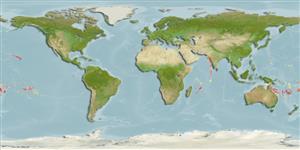Malacostraca |
Decapoda |
Scyllaridae
Environment: milieu / climate zone / depth range / distribution range
Ecology
Benthic; depth range 1 - 60 m (Ref. 96667). Tropical; 24°N - 33°S, 52°E - 104°W (Ref. 4)
Indo-Pacific. Tropical and subtropical.
Length at first maturity / Size / Weight / Age
Maturity: Lm ? range ? - ? cm Max length : 6.0 cm CL male/unsexed; (Ref. 122328); common length : 17.0 cm TL male/unsexed; (Ref. 4)
Assumed common body length is 17 cm, and carapace length is 1.5 to 6 cm. It is of little importance as food; the aquarium trade discovered that 'when imported, their bright colours (for a slipper lobster) and unusual form make them popular and expensive novelties' (Ref. 4). Occurs at a depth range from 5 to 50 m and is found on the outer edges of coral reefs. They seem to be scavengers and feed on detritus. It is nocturnal and hide in the daytime in cavities in the rocks (Ref. 4).
Life cycle and mating behavior
Maturity | Reproduction | Spawning | Eggs | Fecundity | Larvae
Members of the order Decapoda are mostly gonochoric. Mating behavior: Precopulatory courtship ritual is common (through olfactory and tactile cues); usually indirect sperm transfer.
Holthuis, L.B. 1991. (Ref. 4)
IUCN Red List Status (Ref. 130435)
CITES status (Ref. 108899)
Not Evaluated
Not Evaluated
Threat to humans
Human uses
Fisheries: minor commercial
| FishSource |
Tools
More information
Age/SizeGrowthLength-weightLength-lengthMorphologyLarvaeAbundance
Internet sources
Estimates based on models
Preferred temperature
(Ref.
115969): 24.4 - 28, mean 26.6 (based on 124 cells).
